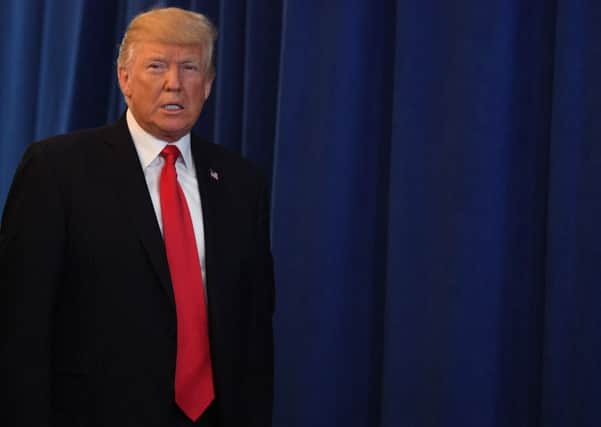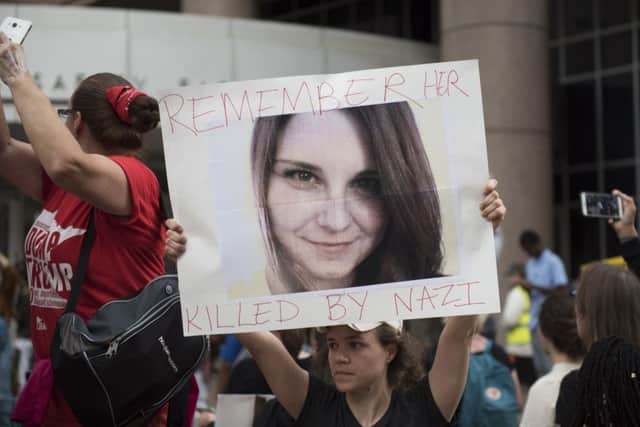Donald Trump claims '˜blame on both sides' in Charlottesville


He appeared to once again equate the actions of white supremacist groups and those protesting against them, and showed sympathy for the fringe groups’ efforts to preserve Confederate monuments.
The president’s comments effectively wiped away his more conventional statement a day earlier when he branded members of the Ku Klux Klan, neo-Nazis and white supremacists who take part in violence as “criminals and thugs.”
Advertisement
Hide AdAdvertisement
Hide AdMr Trump’s advisers had hoped those remarks might quell heavy criticism from Republicans, Democrats and business leaders.
But the president’s retorts on Tuesday suggested he had been a reluctant participant in that clean-up effort and renewed questions about why he seems to struggle to unequivocally condemn white nationalists.
There was renewed criticism, including from fellow Republicans. Senator Marco Rubio of Florida said Mr Trump should not allow white supremacists “to share only part of the blame”.
House Speaker Paul Ryan declared “white supremacy is repulsive” and there should be “no moral ambiguity”.
Mr Trump’s remarks were welcomed by former KKK leader David Duke, who tweeted: “Thank you President Trump for your honesty & courage to tell the truth.”


Violence broke out on Saturday in Charlottesville after a mix of white nationalists, neo-Nazis and other far-right extremists assembled to protest against the city’s decision to remove a towering statue of Confederate General Robert E Lee.
Heather Heyer, 32, was killed when a man ploughed his car into a crowd of counter-protesters.
In the immediate aftermath, Mr Trump placed the blame on “many sides”, and on Monday, at the urging of his aides, he delivered a more direct condemnation of white supremacists.
Advertisement
Hide AdAdvertisement
Hide AdBut he returned to his original arguments on Tuesday during an impromptu press conference in the lobby of his Manhattan skyscraper, declaring “there are two sides to a story”.


He acknowledged there were “some very bad people” looking for trouble in the group protesting against plans to remove the statue.
“But you also had people that were very fine people, on both sides,” he said.
The president sided with those seeking to maintain the monument to Lee, equating him with some of the nation’s founders who also owned slaves.
“Confederate monuments have become rallying points for supporters of both preserving and toppling them.
“So, this week it’s Robert E Lee,” he said. “I noticed that Stonewall Jackson’s coming down. I wonder, is it George Washington next week and is it Thomas Jefferson the week after?
“You really do have to ask yourself where does it stop? You’re changing history. You’re changing culture.”
The president’s comments mirrored rhetoric from the far-right fringe. A post on Monday by the publisher of The Daily Stormer, a notorious neo-Nazi website, predicted that protesters are going to demand the Washington Monument be torn down.
Advertisement
Hide AdAdvertisement
Hide AdMr Trump’s handling of the weekend violence has raised new and troubling questions, even among some supporters.
Members of his own Republican Party have pressured him to be more vigorous in criticising bigoted groups, and business leaders have begun abandoning a White House jobs panel in response to his comments.
Democrats were aghast at Mr Trump’s comments, with Senator Tim Kaine of Virginia saying on Twitter the Charlottesville violence “was fuelled by one side: white supremacists spreading racism, intolerance & intimidation.
“Those are the facts.”
Senator Brian Schatz of Hawaii said: “As a Jew, as an American, as a human, words cannot express my disgust and disappointment. This is not my president.”
Mr Trump, who has quickly deemed other deadly incidents in the US and around the world acts of terrorism, waffled when asked whether the car death was a terrorist attack.
He said: “There is a question. Is it murder? Is it terrorism? And then you get into legal semantics. The driver of the car is a murderer and what he did was a horrible, horrible, inexcusable thing.”